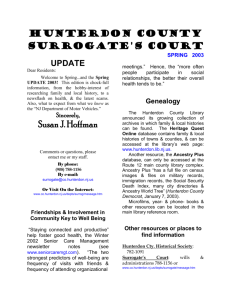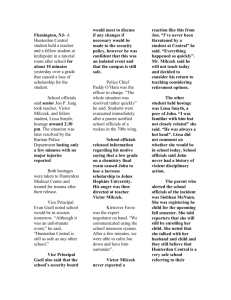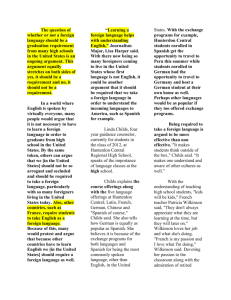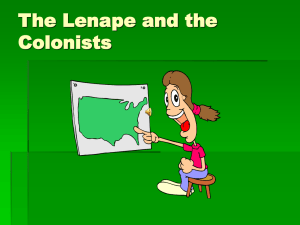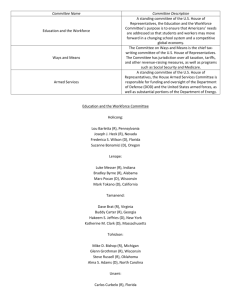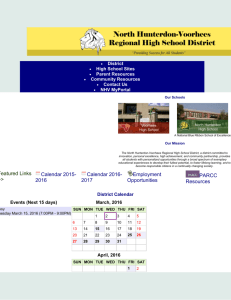Hunterdon Herald Vol #2
advertisement
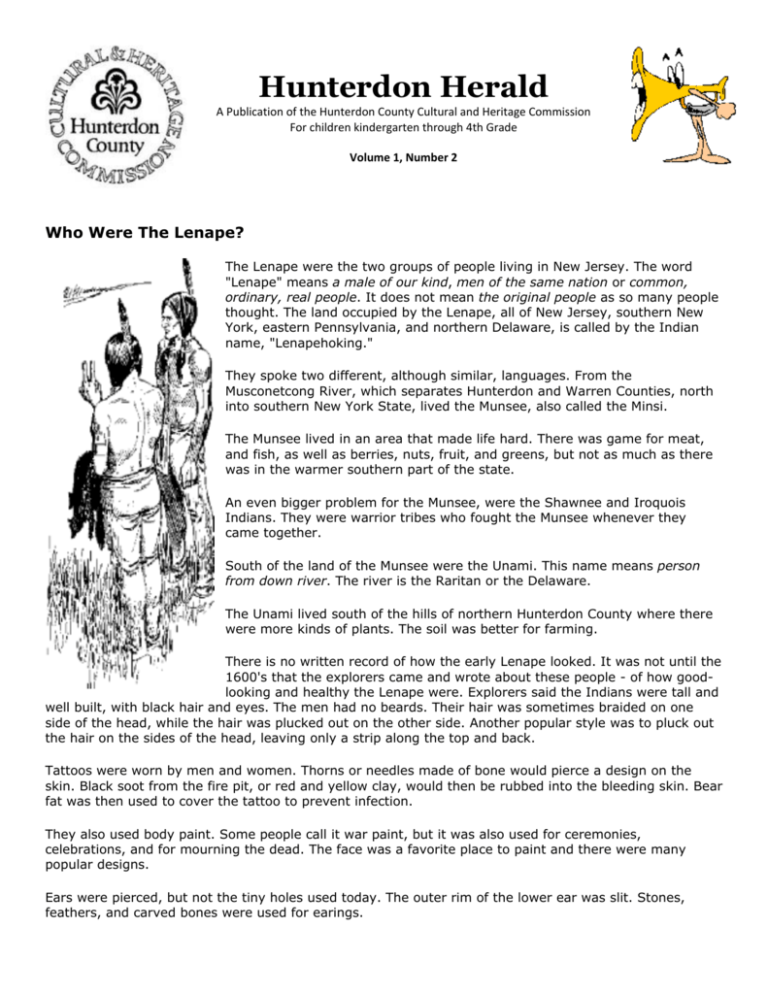
Hunterdon Herald A Publication of the Hunterdon County Cultural and Heritage Commission For children kindergarten through 4th Grade Volume 1, Number 2 Who Were The Lenape? The Lenape were the two groups of people living in New Jersey. The word "Lenape" means a male of our kind, men of the same nation or common, ordinary, real people. It does not mean the original people as so many people thought. The land occupied by the Lenape, all of New Jersey, southern New York, eastern Pennsylvania, and northern Delaware, is called by the Indian name, "Lenapehoking." They spoke two different, although similar, languages. From the Musconetcong River, which separates Hunterdon and Warren Counties, north into southern New York State, lived the Munsee, also called the Minsi. The Munsee lived in an area that made life hard. There was game for meat, and fish, as well as berries, nuts, fruit, and greens, but not as much as there was in the warmer southern part of the state. An even bigger problem for the Munsee, were the Shawnee and Iroquois Indians. They were warrior tribes who fought the Munsee whenever they came together. South of the land of the Munsee were the Unami. This name means person from down river. The river is the Raritan or the Delaware. The Unami lived south of the hills of northern Hunterdon County where there were more kinds of plants. The soil was better for farming. There is no written record of how the early Lenape looked. It was not until the 1600's that the explorers came and wrote about these people - of how goodlooking and healthy the Lenape were. Explorers said the Indians were tall and well built, with black hair and eyes. The men had no beards. Their hair was sometimes braided on one side of the head, while the hair was plucked out on the other side. Another popular style was to pluck out the hair on the sides of the head, leaving only a strip along the top and back. Tattoos were worn by men and women. Thorns or needles made of bone would pierce a design on the skin. Black soot from the fire pit, or red and yellow clay, would then be rubbed into the bleeding skin. Bear fat was then used to cover the tattoo to prevent infection. They also used body paint. Some people call it war paint, but it was also used for ceremonies, celebrations, and for mourning the dead. The face was a favorite place to paint and there were many popular designs. Ears were pierced, but not the tiny holes used today. The outer rim of the lower ear was slit. Stones, feathers, and carved bones were used for earings. Women used face paint, but not in the designs used by men. They would paint a red circle on each cheek. The red paint might also be used on the eyelids, top of the head, ears and temples. Black paint might be used around the eyes. Their long hair was usually loose, neatly kept with a hair band, or with a gorget which were small pieces of decorated slate tied in the hair with a leather thong. In warm weather men wore deerskin breechcloths, which were tied at the waist with a leather thong. Indians also wore moccasins of leather or shoes of woven corn husks, a necklace, and a skin tobacco pouch was tied around the neck or waist. In winter they wore fur capes and leggings. Women wore deerskin wrap skirts in the summer. They added fur capes and leggings in the winter. Young girls made themselves a cape of turkey feathers, woven in fancy designs. These cloaks showed off a girl's talents. Necklaces, earrings, armbands, and deer hair neck coils were also worn. A Lenape man and woman each had their own separate jobs; each knew survival meant helping each other. The Lenape believed in one god, called the Creator. One legend says that the bridge to heaven is guarded by dogs. Anyone who is cruel to an animal is kept from joining the Creator. The Creator had helpers to do various jobs. The most popular helper was Mesingw. His job was to protect the animals, but he also had to see that man had enough to eat. The way he did this was to tell the animals that some of them would have to give up their lives to feed man, but after death they would be born again and be even more beautiful. He told man never to kill more animals than were needed to feed their family. Before killing an animal, man must ask its permission. After, tobacco must be offered at the site of the kill to be sure the animal's spirit is released. A wooden mask of Mesingw was used in ceremonies. Half of the face was painted red, the other half black. Many Lenape wore a necklace with a stone face of Mesingw for luck. They believed that Mesingw could grant any wish. Activity: Draw a picture of a Lenape Indian with designs on the face and body. Questions to Answer: 1. 2. 3. 4. 5. 6. Did Indians kill more animals than their families needed? What did the Lenape call their god? In what ways were the Munsee and the Unami alike? In what ways were they different? Tell what Unami means. Why was Mesingw important? What tribes did the Munsee fight? They Hanged Him! David Reynolds opened his stone tavern In 1763. It was close to the Union Forge so the workers would have a place to eat and sleep, play cards and visit with each other. There had been no public meeting place before David opened his tavern. After the British Parliament passed the Stamp Act of 1765, which meant that the colonists would have to pay more taxes, the farmers in Bethlehem Township formed the "Sons of Liberty." Meetings were held at David Reynolds’ tavern. Citizens were angry and plans were made to do away with the dreaded Stamp Act. David Reynolds was even more unhappy than most men. He came to America because there was no work in England. Now he could see that England was planning to tax the American colonists more and more. He was so angry that he started to counterfeit money! Oh, he was clever. His counterfeit press was on the third floor of his tavern, hidden in the side of the chimney where no one could see it. He even had windows facing the road so that he could see anyone coming up the road. Well, even the best secrets have a way of getting out - and that's what happened to David Reynolds. One day he was printing money, when he turned around to see British soldiers standing there! They had put burlap on their horses' hooves and sneaked up the back way. David never even heard them coming! Sadly for David Reynolds, the soldiers took him off and hanged him that very day. In those days counterfeiting meant death! David Reynolds’ stone tavern stands today on the corner of Charlestown Road and Norton Road in Bethlehem Township. Union Forge, if it were still standing, would be under Spruce Run Reservoir. Cannonballs Made In Hunterdon County Iron ore was plentiful in the hills of Hunterdon and was discovered long before the Revolutionary War. There were iron mines in many of the northern townships, but none proved so successful as the iron mines in what is now known as the Borough of High Bridge. Even today, from time to time, you read about a mine shaft suddenly opening in someone's backyard or driveway. People who live in High Bridge have lived with that concern for years. Long before the Revolutionary War, two men - named Allen and Turner - set up a forge where Spruce Run Reservoir is today. It was the first forge in the New World (the United States). Iron was mined in High Bridge. Long bars were made of iron, and were then shipped to England. Remember, we were a colony of England, and everything made here had to be sent back to England to be made into useable goods. The English would then send the goods back to America to be sold to the colonists. Soon the colonists tired of that situation and wanted to produce their own goods for a profit. One of the many reasons for the Revolutionary War was just that. England wanted to keep all of the profits from the raw minerals mined in America. When the Revolutionary War broke out, the forge was run by Mr. Robert Taylor - and he was a patriot. He named the forge "Union Forge" to show his patriotism. With the great need for cannonballs for the army, Taylor's Union Forge produced as many as possible. The cannonballs were loaded on horse drawn wagons and shipped to Washington's Army at Trenton, New Brunswick and Philadelphia. Mr. Taylor's Union Forge did its share in helping George Washington defeat the British and create a free country - the United States of America! Activities: 1. 2. 3. 4. Find High Bridge on your map of Hunterdon. Look up the word "forge" in your dictionary; define it. Talk about a mine shaft. What is it? What would be found in it? Find Spruce Run Reservoir on your map. New Jersey Turnpike Through Hunterdon County Started In 1806 Building of the first New Jersey Turnpike started in 1806 - and part of it went straight through Hunterdon County! If you have ever ridden on a Turnpike road you will remember that every so often your parents had pay a toll. Well, that's exactly what people did in the early 1800's. Roads were so bad that travel was almost impossible except during the summer. Groups of businessmen got together and formed Turnpike Companies. The purpose of the Turnpike was to charge tolls for those who traveled on the road, and with that money travelers were guaranteed better roads. People were so happy with the thought of passable roads that they invested money in Turnpike bonds. Bonds provided money to dig the road, then the tolls would pay for the upkeep and pay back the bond holders. "Just think," said many people, "we'll be able to take our goods to market anytime of the year. We will be able to visit our families who live farther to the east or west. The Turnpike road will do good things for us." The New Jersey Turnpike was mapped out by surveyors. It was to run from New Brunswick to Phillipsburg, where travelers could then take a boat across the Delaware River to Easton, Pa. At that time New Brunswick and Easton were large cities and important trading centers. New Brunswick, which Is located on the Raritan River, had a deep port. Sailing ships could come in from across the ocean and dock at New Brunswick. Easton had been an important Indian trading center, and continued to be a big business center even after the Indians had moved away. Unfortunately, the Turnpike road through Hunterdon County proved to be difficult to build and even harder to maintain, especially in the bad weather. It was built - and it was used by wagons and coaches going back and forth to market - but tolls were never charged in Hunterdon due to the rough road. By 1832 the whole project was dropped. Name That Town! How do settlements and towns get their names? One way is by a business in the area. Today you may say, “I’m going to the Mall,” no matter which store you’re going to; people 200 years ago talked the same way. When they said, “I’m going to Hunt’s Mills,” it might mean any shop near Mr. Hunt’s mill. Daniel Hunt and his son Ralph built several mills near a waterfall. Their mills were places where farmers could have their ground into flour or animal feed. Farmers had to wait while the grain was being ground. Merchants opened shops for the farmers to buy supplies for their farms and homes. Soon there was a settlement around the mills, which everybody called Hunts Mills. It became the settlement’s name. After a while Mr. Hunt sold his business, so it wasn’t Hunt’s Mill any more. The people decided the settlement needed a new name. But what? There were a lot of businesses in the settlement now. They could not pick just one. Someone said they should name the settlement after a hero. The year was 1828 and a hero of the time was a man named DeWitt Clinton. So the people voted to name the settlement Clinton, a name it still has. Mr. Thomas Lowrey owned a very large farm near the Delaware River. It was so big people called the area around his farm Lowreyville, after him. Businesses grew-up nearby. There was a grain mill to grind flour and two saw mills to cut trees into wood. The settlement was near a point in the river that was easy for travelers to cross. Such a place in a river is called a ford. The mill and the ford were part of Lowreyville. As time went by, it was called Mill-Ford, then Milford - the name it still has. A place where two railroads come together is called a junction. A large settlement grew-up around the area where the New Jersey Central and the Delaware, Lackawanna & Western Railroads met. The town was known as Junction for years. The people who lived there wanted a different name. The settlement next door was known as New Hampton, after the town in England. The people voted to change the name of Junction to Hampton. Activities: 1. DeWitt Clinton lived long before TV or movies; he never wrote a hit song; and he was never president of the United States. Yet there are 25 towns in the United States named in his honor. Use an encyclopedia to find out what DeWitt Clinton did that made him so famous. 2. Mills are just as important to us as they were to farmers 200 years ago. There are many types of mills. Using an encyclopedia or library books, find out about the different kinds of mills. 3. Most people travel by cars today, but there are still many miles of railroads. Using maps of New Jersey and Hunterdon County, find the routes of today’s railroads. Are there still junctions? Where are they? What else can you find out about railroads from maps? WORD SEARCH Print out this page and see how many of the following words can you find? Seek them by reading forward, backward, up, down, and diagonally - always in a straight line. Some of the letters in the diagram are used in more than one word and some are not used in any words. When you locate a word in the diagram, draw a loop around it. Put a check mark next to the word in the word list. C CANNONBALL COLONIST FARMER IROQUOIS LENAPE A N N O N MILL MUSCONETCONG SETTLEMENT TATTOO TURNPIKE B A L L A COACH DELAWARE GORGET JUNCTION MESINGW L E O A T V R G T A Y L O R I T F E P U N O I T C N U J R R R P F A R L T M S C A E S P O A Q L T N L B U A O L S E N Q D U I R P A R N B L U D W R U N A M I I M U S C O N E T C O N G T O K E A E A N E L A N I O O N T E S N E S I S A T A S E R A R S I E A H S E W O L H G G R S Q N C A A T N A O E C L E G Y L G N A W E R R N M L O T I R L W L E N A P E T I H R A M R F A R M E R I T M H I B E A E T U T N E M E L T T E S R I H MUNSEE PATRIOT SHAWNEE TAYLOR UNAMI The HCC&HC is committed to the preservation of Hunterdon County history and offer Hunterdon Herald as an aid in assisting teachers in their efforts to expose students to the rich heritage of our County. Acknowledgements: This newspaper is printed and distributed at no charge to all Hunterdon county 4th grade students through the courtesy of Merck & Co., Inc. Merck Creative Services is gratefully acknowledged for layout and design, and the Hunterdon County Democrat for permission to reprint illustrations originally published in Hunterdon’s Role In The Revolution, a July 26, 1976 special Bicentennial Year publication. Cultural & Heritage Commissioners and staff contributing to this issue are: Frank K. Curcio, Maude Kenyon, Donna M. Jenssen and Stephanie B. Stevens. Additional information concerning cultural and historical organizations, records and endeavors is available through the office located at 3 Chorister Place, Flemington. Write to: Hunterdon County Cultural & Heritage Commission, c/o Administration Bldg., 71 Main St., Flemington, NJ 08822 or call 908-788-1256. Visit our web site at: http://www.co.hunterdon.nj.us
